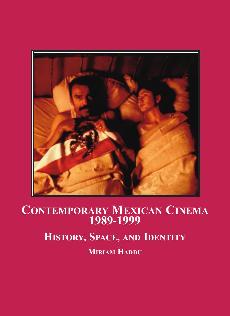This is our backup site. Click here to visit our main site at MellenPress.com
Contemporary Mexican Cinema, 1989-1999

| Author: | Miriam Haddu | |
| Year: | 2007 | |
| Pages: | 284 | |
| ISBN: | 0-7734-5433-0 978-0-7734-5433-0 | |
| Price: | $199.95 | |
This study examines, contextualizes, and evaluates the significance of contemporary Mexican filmmaking, focusing on the so-called ‘cine nuevo’ of 1989-1999. Accordingly, the study is divided into three sections, representing the key generic discourses that frame the films’ narratives and underlying aims: The first analyzes contemporary Mexican cinema’s re-presentation of history on the cinematic screen; the second part of the book examines the rise in the number of women directors, comparing it with the previous lack of female participation within the filmmaking arena; the last section explores the re-location of cinematic geographies in contemporary cinema.
Reviews
“With its succinct film analyses and rigorous contextualization, this book charts a decade of cinematic innovation and experimentation, illustrating the extent to which contemporary filmmakers are forging a compelling and important dialogue about mexicanidad in the twenty-first century ... This book goes some way in providing precisely that space and it is to be hoped that its readers will seize the opportunity with relish.” – Dr. Nuala Finnegan, Centre for Mexican Studies, University College Cork
“With an abundance of information, written in clear and simple language, this book covers the facts, figures, faces and films that reconfigured Mexican cinema in the last decade of the twentieth century; a period of time not many Mexican film scholars have researched into, perhaps because of the recent nature of the events, contextualized within an industry overshadowed by the effects of NAFTA.” – Maximiliano Maza Pérez, Professor and Researcher of Mexican Cinema, Technological Institute of Monterrey
“This will be a valuable addition to the expanding corpus of English-language books on Mexican cinema, which is spreading knowledge of one of the world’s important film industries. Dr. Haddu writes in a clear and engaging style, happily free of the jargon with which much film literature is burdened. Thus her book will be accessible and useful to both film scholars and students.” – Professor Carl J. Mora, University of New Mexico
“With an abundance of information, written in clear and simple language, this book covers the facts, figures, faces and films that reconfigured Mexican cinema in the last decade of the twentieth century; a period of time not many Mexican film scholars have researched into, perhaps because of the recent nature of the events, contextualized within an industry overshadowed by the effects of NAFTA.” – Maximiliano Maza Pérez, Professor and Researcher of Mexican Cinema, Technological Institute of Monterrey
“This will be a valuable addition to the expanding corpus of English-language books on Mexican cinema, which is spreading knowledge of one of the world’s important film industries. Dr. Haddu writes in a clear and engaging style, happily free of the jargon with which much film literature is burdened. Thus her book will be accessible and useful to both film scholars and students.” – Professor Carl J. Mora, University of New Mexico
Table of Contents
List of Illustrations
Preface by Dr. Nuala Finnegan
Acknowledgements
Introduction – Mexican Filmmaking in the 1990s
Part One: History
1 Political Histories: Three Case Studies
2 Re-writing the Conquest: Nicolás Echevarría’s Cabeza de Vaca (1992) and Salvador Carrasco’s La Otra Conquista (1999)
Part Two: Women behind the Camera
3 Re-defining la madre mexicana in María Novaro’s Lola (1989)
4 Retorno al arrabal: The Case Dana Rotberg’s Angel de fuego (1992)
Part Three: Geographical (Re)Locations 5 Re-Mapping the Borderlands: María Novaro’s El jardín del Edén (1994)
6 Mexico’s Other Geographies: The Big City vs. The Country
Conclusion
Bibliography
Index
Preface by Dr. Nuala Finnegan
Acknowledgements
Introduction – Mexican Filmmaking in the 1990s
Part One: History
1 Political Histories: Three Case Studies
2 Re-writing the Conquest: Nicolás Echevarría’s Cabeza de Vaca (1992) and Salvador Carrasco’s La Otra Conquista (1999)
Part Two: Women behind the Camera
3 Re-defining la madre mexicana in María Novaro’s Lola (1989)
4 Retorno al arrabal: The Case Dana Rotberg’s Angel de fuego (1992)
Part Three: Geographical (Re)Locations 5 Re-Mapping the Borderlands: María Novaro’s El jardín del Edén (1994)
6 Mexico’s Other Geographies: The Big City vs. The Country
Conclusion
Bibliography
Index
